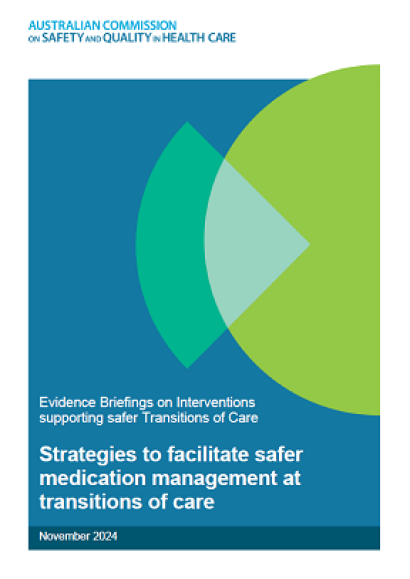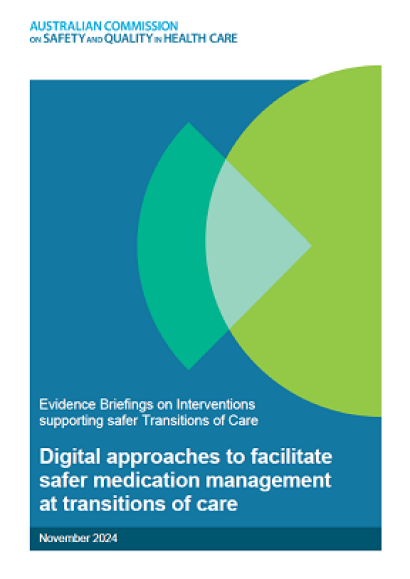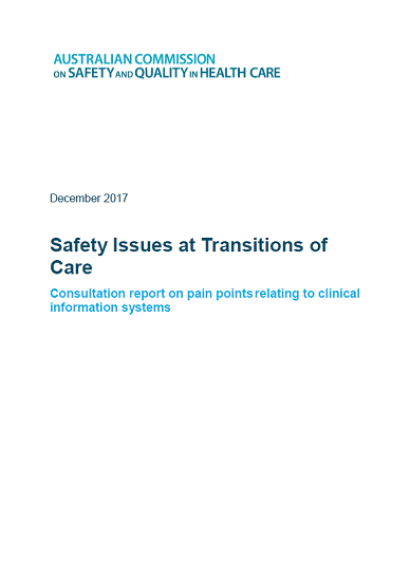Transitions of Care
The Commission leads and coordinates national initiatives to reduce harm associated with transitions of care. This work addresses the risks for patients moving between healthcare providers including primary, community, acute, subacute, and aged and disability care. Information developed by the Commission helps health service organisations and clinicians identify and implement strategies for improvement.
Public consultation on the draft Medication Management at Transitions of Care Stewardship Framework has now closed. The Commission is carefully considering the feedback received which will inform the final Framework.
Evidence briefings on interventions supporting safer transitions of care
These evidence briefings summarise the evidence on the effectiveness of interventions that aim to improve medication management at transitions of care.
The 2024 evidence briefings on strategies and digital approaches to facilitate safer medication management at transitions of care include:
What is a transition of care?
A transition of care is when all, or part, of a person’s health care is transferred between care providers. This may involve transfer of responsibility for some aspects of a person’s health care, or all of their health care. It may be temporary - to manage a brief illness, or long term - due to a permanent change in health status. Transitions of care may occur within and between healthcare locations, settings, care delivery types, levels of care and involve a range of health care providers.
Key triggers for transitions are changes in:
- life cycle
- health status
- population risk
Types of transitions of care
| Type of transition | Example |
|---|---|
| Between care types | a person’s general practitioner (GP) refers them to an allied health professional |
| Between healthcare providers | responsibility of a person’s health care is handed over from one nurse to another during clinical handover in a hospital |
| Between levels of care in the same location | a person is transferred from an emergency department (ED) to an intensive care unit within a hospital |
| Between healthcare locations or settings | in an emergency, a person is attended to by an ambulance service and is transferred to an acute care service |
| When care needs change | a person is transferred from an acute care service to an aged care home using telehealth |
| When a person’s preferences change | a person is transferred from an oncology ward in an acute care service to a palliative care service due to end-of-life care preferences |
| When access to services change | a person’s ongoing care is transitioned from paediatric and youth mental health services to adult mental health services |
| between levels of healthcare | a person is discharged from a mental health inpatient facility back to their GP |
Why are transitions of care important?
Health system data, the health literature, and the Royal Commission into Aged Care Quality and Safety findings indicate people are at higher risk of harm during transitions of care. As a patient’s health care needs increase in complexity, there is often increased interaction with different parts of the healthcare system resulting in more transitions of care. Due to this increased exposure, it is also often the most vulnerable (older people, people with disability and chronic and complex conditions) who are at greater risk of harm.
Poor transitions of care are associated with adverse events such as higher rates of readmission to hospital and medication errors. More than 50% of all medication errors occur when people move from one healthcare setting to another.
Effectively ensuring the quality and safety of health care depends on efficient and effective communication of information between these central clinicians, the broader clinical team and the person.
In 2017, the Commission published a consultation report:
This report looks at transitions of care and identifies key safety issues, pain points and opportunities for improvement in clinical systems. It describes the outcomes of consultations undertaken by the Commission on behalf of the National Health Chief Information Officer (CIO) Forum.
Principles for safe and high-quality transitions of care
The Principles of Transitions of Care and their enablers, developed by the Commission, support safe and high-quality transitions of care within Australia. These principles and enablers should apply to transitions of care wherever health care is received including primary, community, acute, subacute, aged care, and disability care.
Further resources
- Transitions of care case study: Aged Care Emergency service
The Aged Care Emergency (ACE) service is a nurse-led multi-agency model of care in the Hunter New England and Central Coast areas of NSW. It provides triage and clinical support and advice for residential aged care facility staff so that care for residents can be delivered in the facility where appropriate to avoid unnecessary transfer to hospital.
- Communicating for Safety Resources Portal
The portal is designed to provide clinicians and health service managers with an easy navigable repository of resources to support clinical communication, improvement and implementation of the National Safety and Quality Health Service (NSQHS) Standards (second edition). It includes an implementation toolkit for Clinical Handover Improvement and guidance on the use of the ISBAR communication tool.
- WHO Global Patient Safety Challenge Medication without harm
In March 2017, the World Health Organization (WHO) launched the third Global Patient Safety Challenge with the theme of medication without harm. In Australia, the goal is to reduce medication errors, adverse drug events and medication-related hospital admissions by 50% by 2025. The response examines existing programs that address the three WHO flagship areas, which includes ‘Improving medication safety at transitions of care with focus on a shared medicines list’.
- Guiding principles to achieve continuity in medication management collection
The Guiding Principles underpin the National Medicines Policy. They promote practice that keeps the individual receiving care at the centre of an integrated health system. They set a framework for providing comprehensive continuity of medication management for all individuals receiving care and include actions to support vulnerable groups that use the healthcare system.




